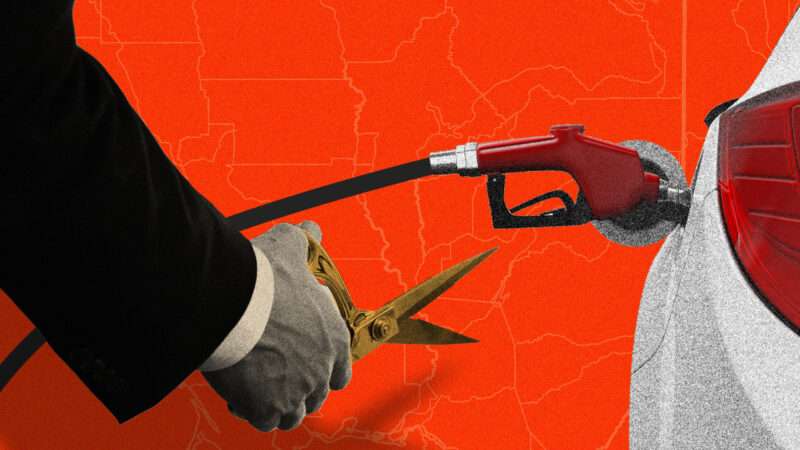
One of the mainstays of California's state government is the obvious disconnect between its leaders' highfalutin' rhetoric and the real-world results we see here on our streets. The state promises to lead the world in combatting climate change, fighting homelessness, ending income inequality, promoting economic innovation, and you name it.
"Look, people have always looked to California for inspiration," Gov. Gavin Newsom said during his March State of the State address. "California is doing what we have done for generations, lighting out the territory ahead of the rest, expanding the horizon of what's possible."
It makes you wonder where the governor is living. One can consult myriad sources to see that we lead the nation—but not in an inspirational way. We have the largest homeless population, with cities overrun by tent encampments. We have the nation's highest income inequality and least-affordable housing. Our population is falling and businesses pursue their innovations elsewhere.
The most obvious example of this "look how great we are, but don't look too closely" process came in recent weeks, as the California Air Resources Board (CARB) announced new clear-air regulations. The Advanced Clean Cars II rule will—let's say it all together now—lead the nation and perhaps the entire world on a path to a carbon-free future.
In implementing Newsom's 2020 executive order, CARB has issued "trailblazing" rules that put "California on a path to rapidly growing the zero-emission car, pickup truck and SUV market and deliver cleaner air and massive reductions in climate-warming pollution." It establishes a "roadmap so that by 2035 100 percent of new cars and light trucks sold in California will be zero-emission vehicles."
That means California will ban the sale of internal combustion engine vehicles, just as it has banned the sale of new lawnmowers and other power equipment that's powered by gasoline engines. It's the state's latest attempt at technology forcing—"a strategy where a regulator specifies a standard that cannot be met with existing technology, or at least not at an acceptable cost," as Science Direct explains.
Governments can't even competently provide the services they are more than adequately funded to provide, yet presume to tell industry what to do. CARB admits the "timeline is ambitious," but says it's "achievable." Fortunately, the same bureaucrats who mistakenly sent out as much as $31 billion in unemployment benefits aren't responsible for building and marketing the electric replacement vehicles.
The CARB press release was filled with the usual grandiosity about California "leading the nation," "groundbreaking strategies," and "environmental justice" but another recent press release from another California entity offered a more realistic take on what the future might hold as the state forces all of us into buying electric vehicles.
"California and the West are expecting extreme heat that is likely to strain the grid with increased energy demands," according to an August 30 statement from the California Independent System Operator (ISO). "The top three conservation actions are set the thermostats to 78 degrees or higher, avoid using large appliances and charging electric vehicles, and turn off unnecessary lights," it continued (italics added).
To put a finer point on it, the same week that California policy makers announced an ambitious plan to shift California's 27-million drivers into electric vehicles or plug-in hybrids, they also announced that Californians who currently own electric vehicles better not charge them for several days because the grid can't handle the load. Isn't that just so California?
The state's small gasoline engine ban also is instructive. Those CARB rules go into effect in 2024 (or whenever the agency determines it to be feasible), but we're already seeing the impact of the coming change. Consumers are stocking up on gas-powered mowers and generators. (Never mind how odd it is to require electric generators given that people use such generators to provide electricity when the lights go out.)
Manufacturers and retailers are already adjusting to the coming ban. They cost significantly more than gas-powered mowers and can cut significantly less. CARB is right that prices ultimately will come down, just as EV vehicle prices will fall as competition heats up. But instead of sparking an electric revolution, the rules will benefit wealthy people who can afford the extra cost—and encourage everyone else to nurse along their aging equipment.
But don't worry. CARB is offering public subsidies so that poor and disadvantaged Californians can make the transition to electric vehicles. Not only will that tap the budget, but there won't possibly be enough subsidies to go around. CARB also promises that EVs will ultimately cost less to operate, which may be true until one considers the cost of a $20,000 replacement battery.
The market already is moving in the EV direction, so the state should just let companies do their thing. Now if we can only figure out a way for the state to keep the electricity running.
This column was first published in The Orange County Register.
The post California Demands Everyone Drive Electric Vehicles, but Can't Even Keep the Lights on appeared first on Reason.com.







